Consistency Checking
Reading time ~6 minutes
This feature allows you to find and report inconsistent clips and media files. The consistency checking panel is launched via the respective command from the "Consistency checking and diagnostics" submenu of the database context menu:
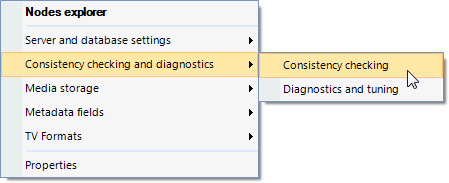
|
Note
|
The operations may be quite time consuming, depending on your database size and SQL Server load. |
|
Caution
|
Never use the same file locations for different databases. This may cause deletion of files in another Cinegy Archive database! |
|
Caution
|
Never use the base path for different media file type shares nested inside each other as file locations; this will lead to the incorrect results when performing the consistency checking operations and to the accidental deletion of media files. |
|
Caution
|
To perform the "Populate a list" operation, ensure that the shares monitored by consistency checker are available for the group of users under which the SQL Server services are started. |
MOGs without Essences
Populate a List
The "Populate a List" functionality allows to search for MOGs (Media Object Groups) without any essence. In the "File types" and "Node types" fields correspondingly select file and node types that should be included into the list.
You can also define a number of rows to be displayed in the populated list by entering the desired value via the keyboard or by pressing the  buttons. The default value is "0", meaning that all rows of the populated list will be displayed.
buttons. The default value is "0", meaning that all rows of the populated list will be displayed.
|
Caution
|
This operation may be quite time-consuming, depending on your database size and SQL Server load. It is recommended to explicitly define the number of rows to be populated for large databases to avoid system overload and considerable time delays. |
Press the "Populate a list" button to list all missing media files. For every file link, the system checks whether the file is physically present at the specified location.
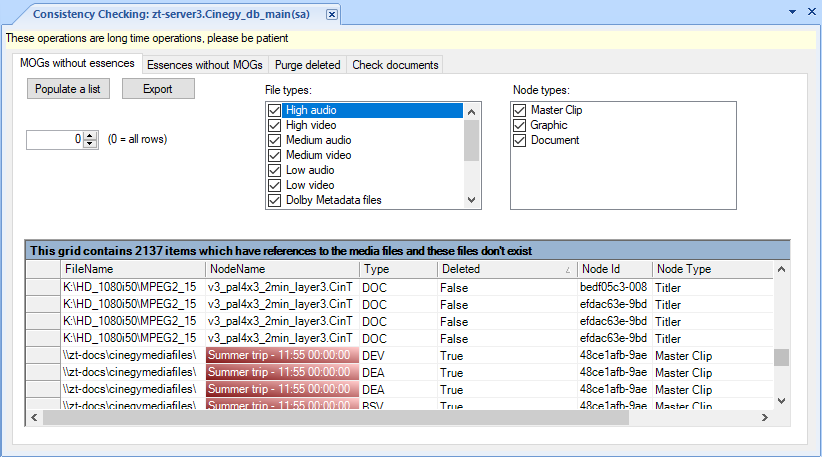
The dialog shows the type and deletion status of the detected media files.
Export the List
To have a better overview of the missing media files, the result of the population can be exported and saved as a TXT file. To do this, use the "Export" button to open the following export window:
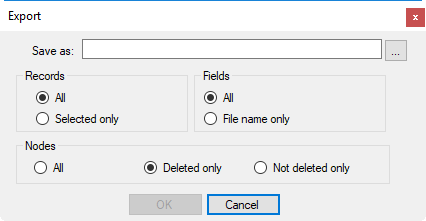
Define the destination folder location for the exported *.txt files, specify the export parameters and press the "OK" button.
Essences without MOGs
The "Essences without MOGs" feature is handy when there is a need to find all files that do not correspond to a MOG (Media Object Group) parameters. The "Settings" section contains two tables: "All available file locations" and "Selected file locations". Select a file location from the "All available file locations" list and move it to the "Selected file locations" on the right by pressing the corresponding arrow button:
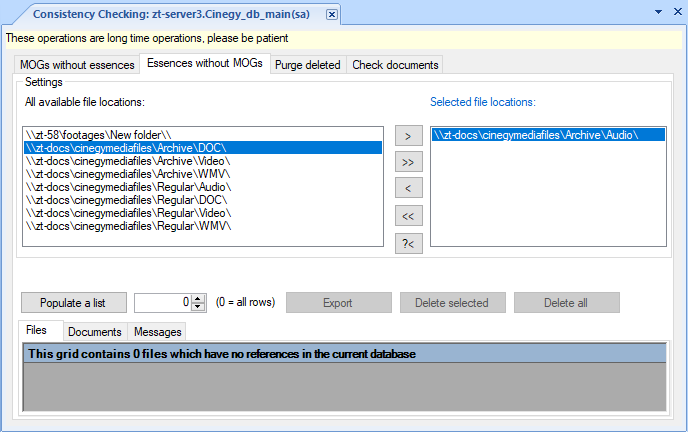
To check a shared file location availability on the SQL Server side, select it in the "Selected file locations" list and press the  button; the following "Check share" dialog appears:
button; the following "Check share" dialog appears:
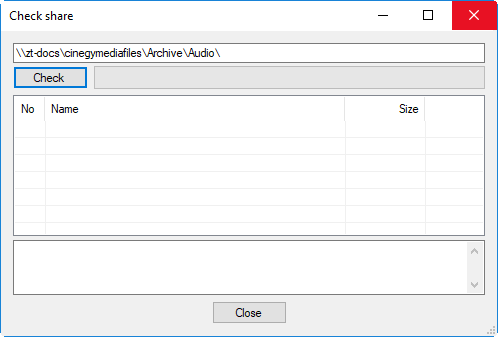
Press the "Check" button; a progress bar will show the check-up progress. When checking is finished, a list of available files on the selected file share is displayed with a number of records in it shown in the corresponding field:
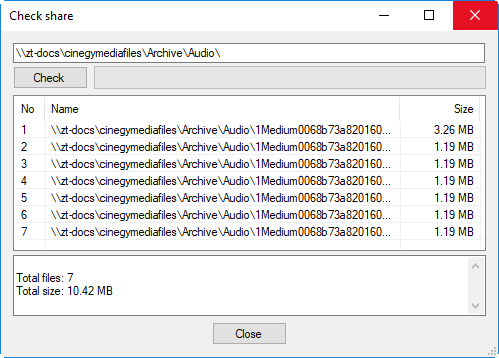
When the file share is not accessible, you will be informed about it with the corresponding message.
Press "Close" to exit the dialog and return to the "Consistency checking" window.
Populate a List
|
Caution
|
The user under which the SQL Server is running should have enough rights to perform the "Populate a list" operation. |
Press the "Populate a list" button to create a list of broken linkages. If Cinegy Archive Manager finds broken references, the results will be listed in the table on the "Files" tab.
You can also define a number of rows to be displayed in the populated list by entering the desired value via the keyboard or by pressing the  buttons. The default value is 0, meaning that all rows of the populated list will be displayed:
buttons. The default value is 0, meaning that all rows of the populated list will be displayed:
|
Note
|
This operation may be quite time-consuming, depending on your database size and SQL Server load. It is recommended to explicitly define the number of rows to be populated for large databases to avoid system overload and considerable time delays. |

Export the List
You can use an exported list for file maintenance and cleanup. The log file contains full file names; every name is in a separate line, saved as a TXT file. Press the "Export" button:
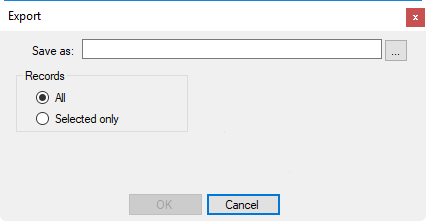
Delete the Files
To clean up the server from the unnecessary file(s), press the "Delete selected" or "Delete all" button.
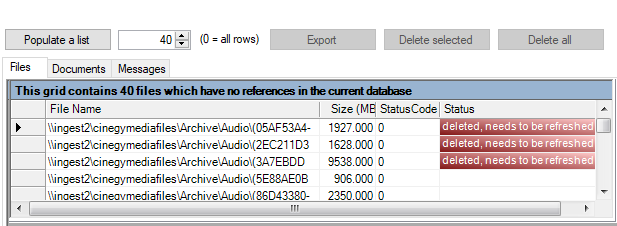
Purge Deleted Nodes
The "Purge deleted" tab allows to remove nodes with the "deleted" status. Press the "Refresh" button to see the latest status:
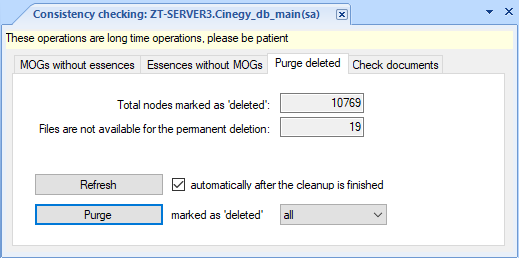
Select the "all" option from the drop-down list next to the "Purge marked as deleted" to purge all nodes. Select "top" and define the number of nodes marked as 'deleted' to be deleted permanently:
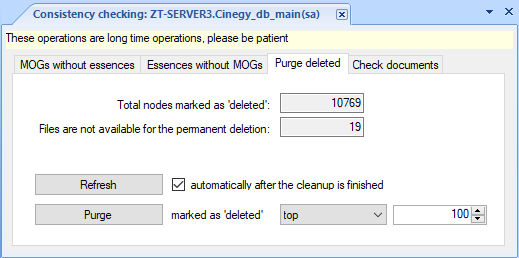
Press "Purge" to start the process and on the confirmation window that appears press the "OK" button to proceed with deleting nodes permanently:
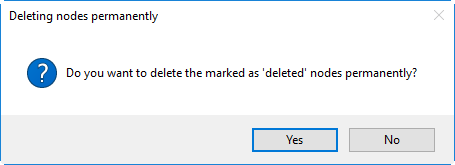
|
Note
|
By this feature the object and its metadata are being deleted, the complete removal of media files is performed as described in the section "Essences without MOGs" above. |
|
Caution
|
This operation is permanent and cannot be undone! Once nodes are purged, they cannot be restored. |
Check for Deleted Documents
Cinegy Archive database consists of metadata nodes, referencing to the physical media files. Documents as well as media files are located on the disk storages.
When deleting a DocumentBin or the documents inside it, the metadata nodes are only "marked as deleted". These nodes become invisible in the explorer tree but still exist in the database structure. The physical media files and documents are not affected.
To delete the documents permanently, go to the "Check documents" tab.
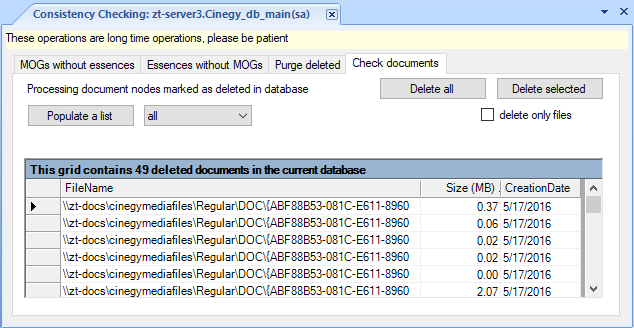
Press the "Populate a list" button to retrieve the list of physical document files referenced by the "marked as deleted" nodes. These are the files available for deletion.
Choose "top" and define the number of documents marked as 'deleted' to be deleted permanently or "all" to purge all documents and press the "Delete all" button. Alternatively, you can manually select the files to be deleted and press the "Delete selected" button to purge them.
Select the "delete only files" checkbox to delete only physical files without deleting the database nodes. As purging "marked as deleted" database nodes is a time consuming operation, the deletion of physical files only may save some time in case of high disk space usage.
|
Caution
|
If the "Purge" operation was previously executed, the references from the "marked as deleted" documents to their physical document files will be deleted and the list of documents available for deletion will not be populated. |